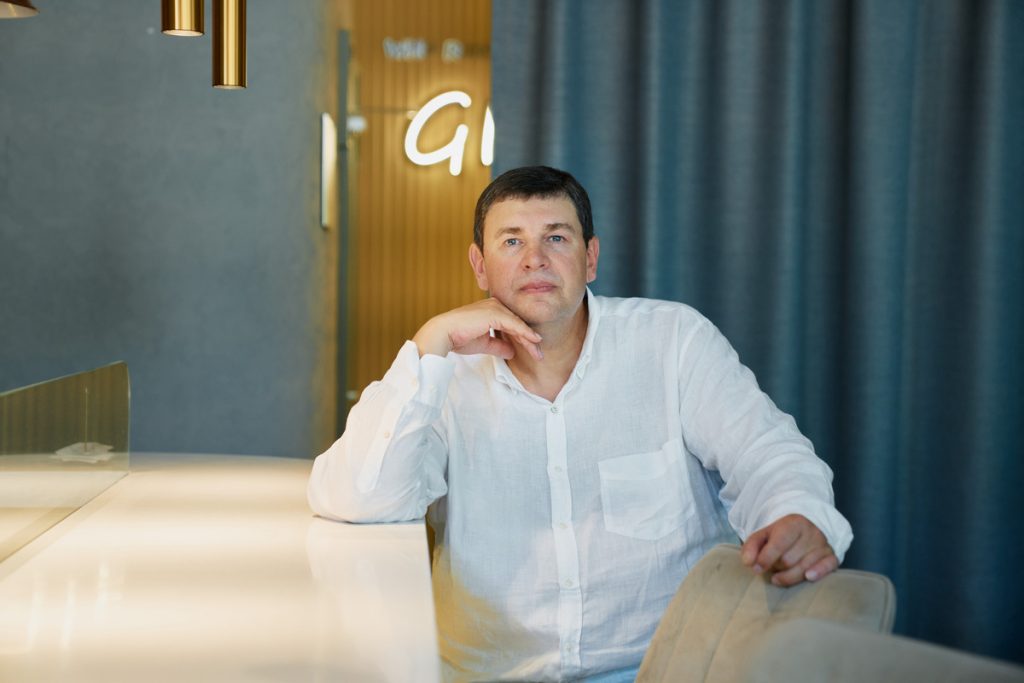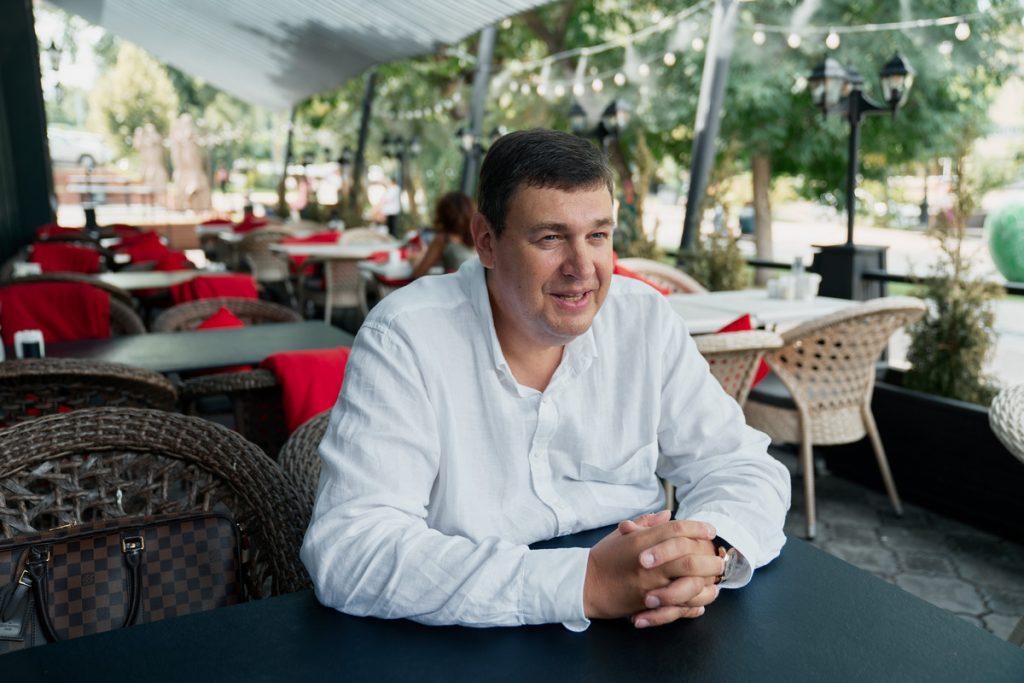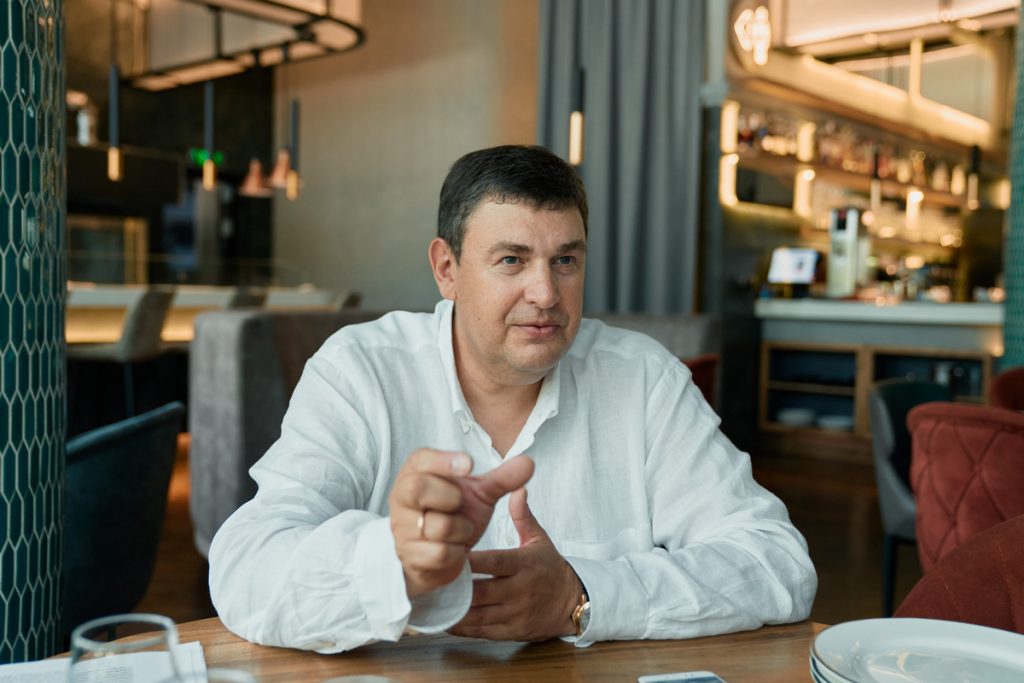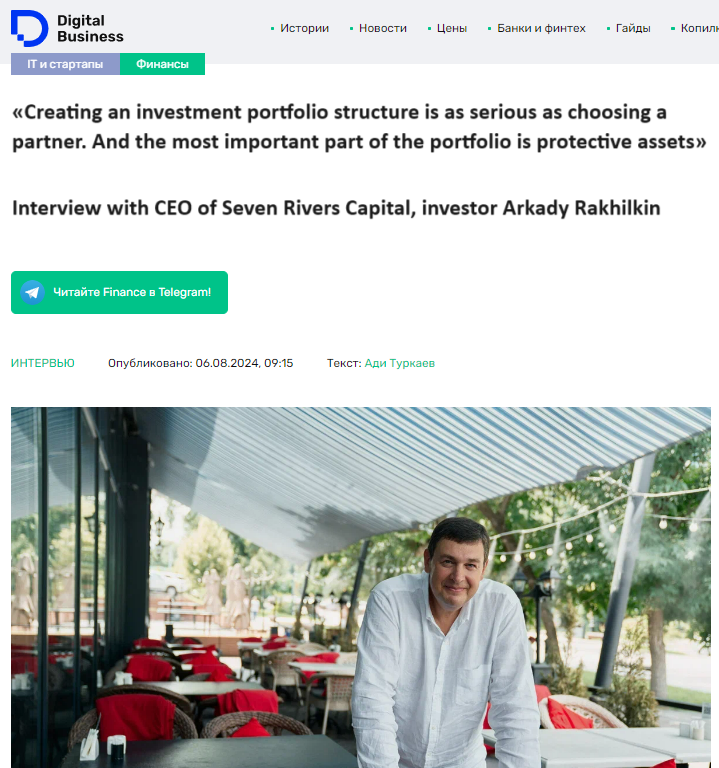Three bright quotes from an interview with Arkady Rakhilkin
I feel sorry for people who spend hours watching the rise or fall of bitcoin on hundreds of YouTube and Telegram channels, while not having professional investment experience, because they will inevitably lose their invested money.
Gold is a liquid asset. But I recommend using gold precisely as a protective asset, and not one on which you can earn a lot of money through speculation.
The housing that you own for living is not an investment. These are your expenses. You pay taxes, maintain it. Only a second home that you buy with money free from obligations is an investment.
— Will you disclose the structure of your investment portfolio?
— We are an investment boutique that focuses on active management of portfolio companies and organizing tailormade transactions for investors. The main investments are concentrated in sharing economics companies, whose share in the global economy is constantly growing.
In our active portfolio, we have startups in Fintech & Marketplace, Digital banking, IaaS, and Web3 White Label Solutions. The teams started their business in Kazakhstan, but in 2022 they began their transition to the MENA region, which fully ended in 2023. Over the course of two years, the main investments of investors were spent on understanding how to scale to unfamiliar markets and what business models to offer to clients. Quantitatively, we have five startups. The most important are LeoPart and S1lkpay.
The second area is investments through our partners, where we can acquire shares of startups in the pre-IPO market. We invested in SpaceX, we have a share in Anthropic and several other companies developing AI. Also in Pakistani fintech TruKKr, crypto exchange Kraken, LPU chip manufacturer Groq.
And thirdly, we manage a portfolio of listed companies in certain industries. I have always really liked the AI topic, ever since we wanted to but couldn’t invest in OpenAI, but invested in Anthropic. Since then, our watch list has accumulated approximately 100 companies for managing the AI portfolio. Such a portfolio provides a significantly higher return than the average investment. Some businesses remained in Kazakhstan, mainly for testing hypotheses and running them in for scaling to future jurisdictions. For example, the online auto parts store LeoPart and fintech S1lkpay are proven algorithms and hypotheses that we transfer to MENA and provide to our partners.
“For an inexperienced investor, real estate, bank deposits gold and gemstones are better suited”
— What investment instruments are most typical for Kazakhstanis? — In recent years, we have heard about “investing in crypto”. I am skeptical about “investing” in global cryptocurrencies, because this is not yet a fully regulated market. Only two months ago, the law on regulating cryptocurrencies Markets in Crypto-Assets (MiCA) was adopted in Europe (the market became fully regulated). We have yet to assess the impact of this event. At the same time, in some countries, the turnover of cryptocurrencies is regulated, in others it is just an asset, in other jurisdictions, crypto is generally prohibited.
But I feel sorry for people who spend hours watching the rise or fall of bitcoin on hundreds of YouTube channels and Telegram, without having professional investment experience, without knowing technical analysis. Because they will inevitably lose the money they invested. Therefore, for most Kazakhstanis, investing in real estate and bank deposits is better suited.
— Don’t you need to study and gain experience here too?
— An ordinary person perceives investing as a kind of game in which you need to win. And their expectations are extremely high. This is an indicator that people are not prepared for investment activities. Every time I explain investments to clients, I start by discouraging them.
When people want to transfer money from deposits to investment activities, the most common question is: what to do that will bring money? But you need to be prepared for the fact that in such a business, the costs are losses. A person must be ready to lose. And this is precisely the most dangerous thing, because when you answer them like this, people say that they did not understand anything: they came to make money.
I explain that out of ten transactions, a maximum of one or two will come out on top. The rest will end up in the red. This picture seems gloomy to citizens, but it is true. Therefore, you need to start with knowledge of protective assets. Many neglect them. No one wants to delve into the topic of protective assets. This is the peculiarity of Kazakhstani investors. It is boring, uninteresting, they pay little for it. Bonds, structured notes and shares of utility companies
— Let’s explain it again. What is a protective assets and what do they protect against?
— These are types of assets that people have used for years as an alternative to money and even real estate. They grow slower than the market, but they also fall less during cataclysms.
When investors ask how to structure their portfolio, I definitely say that at least 30% should be in protective assets. For example, in bonds. They are not so popular among retail clients, but a bond is an instrument that allows a person to return the entire amount that he invested, plus a fixed income. In addition, bonds can be traded. Moreover, there is now a large supply of dollar bonds on the market, with income in dollars. Depending on the degree of risk, it can even be comparable to a bank deposit. It is clear that this is not a complete comparison, because investments in bonds will be returned only at the end of the term, and a bank deposit can be withdrawn early.
It would not hurt to have utility shares as protective assets. These are companies that provide services to life in cities. For example, KEGOC is a company that provides electricity transmission services. They cannot be unprofitable. These are the instruments that must be planned and profitable. But people are always bored to hear about this, because the planned profit here is very low, around 5%.
Gold is a classic protective asset, but it also has disadvantages, although this is rarely discussed.
– What’s wrong with it?
– Gold is a highly liquid asset, but the spread (the difference between the purchase and sale price) is always such that holding it for less than a certain period is simply unprofitable, otherwise you will lose. I recommend using gold precisely as a protective asset, and not as one on which you can earn a lot through speculation.
In addition, gold is an exchange commodity. The price is determined by banks and governments that trade gold in certain volumes on the market. At the same time, Kazakhstanis have it easiest with gold. Why? Our banks and the government have made it possible for individuals to buy refined gold. You can buy or sell gold bars at any bank. That is why it is so popular.
But this is the same as investing in dollars, which in itself sounds like something very far from the word “investment”. You simply keep money in dollars or gold, hoping that the increase will be greater than inflation (so as not to lose money). With a stable tenge exchange rate, these manipulations lose their meaning.
– What is the alternative?
If it is the stock market, then ETF (Exchange-Traded Fund), in which you immediately choose an industry, such as SPY (an exchange-traded fund that tracks the profitability of the S&P 500 Index).
This allows you to take on risks no greater than the collapse of the economy as a whole. Because at some point in the market there is always a difficult moment. It is clear that at the moment of rapid recovery, the most dynamically growing are “growth stocks”, that is, risky ones, in which hopes and expectations are embedded. However, the average investor often sells on the decline and misses the recovery, as he is not ready for losses and thinks only in the short term.
One of the most interesting and elegant protective assets are gemstones. I think we can discuss this topic in a separate conversation.

“Housing that you own for living is not an investment. These are your expenses”
– Let’s return to investments in real estate and deposits. Why are they so popular in Kazakhstan?
– The simplest investment alternative for a family (household) is renting out a one-room investment apartment. The average cost of a one-room apartment in our country is 50-60 thousand dollars. It can be renovated and rented out. But someone has to manage all this, this is also a business.
At the same time, most people have the idea that renting out will bring 30-40% per annum, but this will not happen. It is necessary to take into account the costs of major repairs, taxes, as well as irregularity and seasonality, risks of loss of property, advertising costs and finding clients. If the investor prefers long-term rent rather than daily rent, the risks are much lower, but so is the rate of return. Because you get a guaranteed cash flow, and the fee for it is lower.
Many are surprised when I give an economic breakdown that investments in real estate are 2 times less than the figures they have drawn for themselves. On average, it will amount to 15% of the income from the investment amount per year in dollars. People think that this is not much.
The housing that you own for living is not an investment. These are your expenses. You pay taxes, maintain it. Only the second home that you buy with money free from obligations is an investment. I recommend reading Kiyosaki’s book “Cashflow Quadrant”, which describes everything clearly.
As for deposits, now banks pay from 12 to 17% per annum in tenge on them. And since the Kazakhstani investor is not tempted by the abundance of other available financial instruments, the deposit may well be part of the portfolio.
“The less experience, the less you need to invest in just one company, project or industry”
– Who can you learn investing from without losing money?
– As soon as you invest your hard-earned money in a real (not model) portfolio and start managing it yourself, then as the amounts increase, you will definitely suffer your first losses. It is difficult for inexperienced investors to come to terms with this, but it is so. Without preparation, knowledge and understanding of how it works, a person becomes a hostage to the fear of “recouping losses”. He does not make decisions, but rushes about and, accordingly, loses even more.
– What parts should you divide your portfolio into?
– If you want to become an investor, be sure to diversify: a deposit, the stock market and housing. And housing is not the one you live in. If you rented an apartment cheaply and live in terrible conditions, renting out your own at a high price – this is not a business, this is madness.
Diversification is mandatory and “protective assets” are mandatory. If you want high-risk ones, take a maximum of 30% in your portfolio. If you bet everything, you can lose everything one day. The less experience, the less you should invest in just one company, project or industry. The portfolio structure should be as follows: 30% – risky assets, 30% – protective assets, 30% – real estate and a deposit, the rest – in cash.
– What about Bitcoin? It has crazy profitability, right?
– I’ll give you a simple example. An ordinary nurse from a hospital in Minnesota puts money aside for her child’s education not in a bank deposit, but buys SPY every month for $200, which we talked about above. Why? She believes in America and therefore subsidizes the economy with her money, even if she doesn’t understand it well.
After 10 years, SPY will grow, and she will receive 10% per annum on average. This is a living example of what ordinary citizens do in the USA. Of course, they also lose if they start taking more risks in areas where they don’t understand much (remember the movie “Money Monster”). But the economy of the entire country will not fall. But individual stocks that seem bright and attractive, especially in new areas like cryptocurrencies, can.
In August 2024, the Bitcoin rate fell by 17.5% in 5 days
People’s fascination with the fact that Bitcoin is constantly growing or at some point falls and should grow again is not based on anything. The person who claims that he knows exactly what will happen to a cryptocurrency or a security is definitely a charlatan. Nobody knows what is happening in the market. We can only use certain methods and technical analysis to imagine how an asset will behave in different situations.
The fact that Bitcoin’s capitalization is 30% higher than Warren Buffett’s Berkshire Hathaway raises great doubts in me as a mathematician.
We will definitely come to the world of cryptocurrencies. It will become regulated and understandable, and this is already happening. For example, the digital tenge is a cryptocurrency, only it is regulated by law. What should ordinary people do? No need to get involved in all this. Engage in classic investments, which we have already talked about. Be sure to diversify them and have protective assets.
– And yet. And who should we leave Bitcoin to?
– Professional players. I think that in the near future, cryptocurrencies will become, if not the main, then the key source of transfers. The problems with dollar transfers are obvious. Only 5 banks in America are correspondent banks. Dollar transfers in the world have slowed down dramatically due to new procedures: anti-sanctions, verification of counterparties, documents. Your payments may simply stop at some point if the correspondent bank stops or returns the money back.
Therefore, cryptocurrency will play an important role. Settlements in stablecoins will definitely only increase. Those who are engaged in this business need to understand the real model of such businesses very well. “Our clients have already earned enough for housing, cars, education for their children, and quality healthcare”

— A private investor — who? A person from the Forbes list?
— Our clients are those people whose basic life needs have been met. What do you mean by closed basic needs? They have already earned enough for housing, cars, education for their children, quality healthcare, etc. And they have an amount that exceeds the amount that covers their basic life needs. And then the question arises: what to do with it? They are ready to withdraw money from a deposit and invest in something. I never recommend people who do not have their basic life needs covered, for example, who do not have their own housing, to invest in something.
— How many such people are there?
— I think up to a million investors who have their own investment portfolio in one way or another, if we are talking about minimum investments of $20,000. You can buy something substantial for $50,000.
These are top managers of companies whose salaries cover their own and their families’ needs. And they want to start investing with bonuses or unexpected income. This is the most active part of the population, which mainly live in Kazakhstan. They work and live here. I wish everyone who wants to get in touch with the world of investments to take it as seriously as choosing a life partner. First comes the acquaintance, introduction to parents, study of the family tree and financial situation, then the official engagement ceremony and only then the wedding. Then there will be significantly fewer divorces (investment losses).

